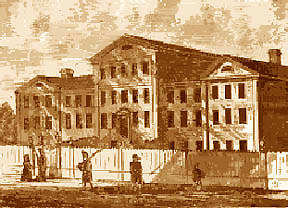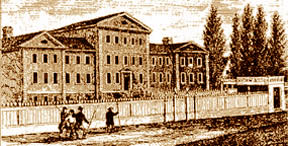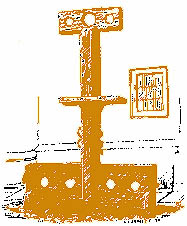xxx

xxx
NYCHS presents excerpts from From Newgate to Dannemora: The Rise of
the Penitentiary in New York, 1796-1848, by W. David Lewis.
Copyright © 1965 by Cornell University; copyright renewed 1993.
Used by permission of the author and the publisher, Cornell
University Press. All rights reserved. Click on image, based on book jacket front cover, to access Cornell University Press site.
|
|
Chapter I: Heritage (Part II)
(Excerpted from Pages 10 through 19)
. . . . the mercantilist
[French] minister Colbert encouraged a systematic policy of consigning
offenders to the galleys. Magistrates, he believed, were wasting
vital manpower through an overuse of capital punishment.
Galley servitude . . . was only one alternative to which various
leaders resorted in the search for more intelligent penal policies.
A development of particular significance was the evolution of the
workhouse, an institution originally designed for the poor which
became in time a type of correctional facility in which beggars,
paupers, vagabonds, petty offenders, and even a number of actual
felons labored at assigned tasks under close supervision.
The
Calvinist emphasis upon work as both a duty and a morally beneficial activity provided an additional stimulus for the widespread
adoption of the workhouse idea. . . .
For both practical and theoretical reasons, therefore,
workhouses spread rapidly after the mid-sixteenth century, when
England began using the London Bridewell as a place of detention
for paupers. . . .
"With the creation and multiplication of workhouses," one
writer [Frederick H. Wines in Punishment and Reformation: A Study of the Penitentiary System] has stated, “the foundation of the modern prison system
was firmly laid.”
xxx
 Sketches of NYC's Bridewell, above and below, do not appear in From Newgate to Dannemora but do appear elsewhere on this web site.
The one above appears in the NYCHS presentation Penitentiary Origins in the City of New York. The one below appears in NYCHS' New York Correction Timeline I next to the year 1775 when building Bridewell in City Hall park was begun. Each Bridewell image is linked to its NYCHS web page. Click for more related information.
xxx

|
|
In view of later industrial developments in
American prisons, it is particularly interesting to note that many
workhouses quickly came to be managed for profit . . . .
Like the prison workshops later to be established in such states as New York, the industrial departments of
European workhouses speedily aroused the anger of free craftsmen,
who tried to secure legal action against what they regarded as unfair competition.
. . . the famous Maison de
Force, founded at Ghent in 1772 as a place of correction for
offenders, mendicants, vagrants, and the like, was an outgrowth of
the workhouse idea . . . it had a
regime of solitary confinement at night and congregate labor by
day which was similar to the system later imposed upon convicts
at Auburn prison.
Early prison reformers in America, including those in New
York, were familiar with the workhouse idea and aware of the
types of discipline practiced at various European institutions. It
is likely that knowledge of these establishments was carried to New Amsterdam by the first Dutch settlers . . . .
Even though England did not utilize such institutions for
the treatment of criminals to the extent that this was done on the
Continent, the British did develop county houses of correction
modeled upon the London Bridewell. . . .
By 1735, New York City had a workhouse
where disobedient slaves and servants were sent for punishment,
various types of vagrants and runaways were forced to labor, and
paupers were given alms in addition to employment in spinning
or farming.
xxx

xxx
The sketch above of an all-in-one punishment device -- pillory, whipping post, and stocks -- does not appear in From Newgate to Dannemora but does appear on this web site in a NYCHS excerpts presentation of On the Penitentiary System in the U.S. and Its Application in France by Gustave de Beaumont & Alexis de Tocqueville. Clicking image accesses that page.
|
|
Later in the century John Howard supplied detailed
information on European workhouses to American readers in his
writings on prison reform. . . .
Punishments in America were not usually as brutal or as frequently inflicted as those which prevailed in many areas of Europe,
but were nevertheless copied from Old World practices. In colonial New York, for example, the jail was chiefly a place for debtors
or for those awaiting trial. For over a century after the founding
of New Amsterdam there was not even a separate prison building
on Manhattan Island. If jail sentences were imposed, they usually
supplemented other punishments or lasted but a short time.
Under
the code of laws introduced after the conquest of the colony by the Duke of York, eleven offenses were made capital, a number which
had increased to sixteen by the late eighteenth century. Public
whipping, pillorying, banishment, branding, stocking, and carting
(tying a culprit to the tail of a wagon and dragging him ignominiously through the streets) were among the punishments imposed
by the magistrates. Flogging was frequently employed, with judges
sentencing offenders to as few as five or as many as one hundred
and fifty lashes . . . .
. . . a
chronic shortage of labor . . . made the wisdom of frequent executions or disabling penalties somewhat dubious. . . . Statistics on the incidence of
capital inflictions, moreover, are distorted by the atypically large
number of cases which occurred in such times of public hysteria
as accompanied the attempted slave insurrection of 1741-1742. . .
xxx

xxx
The Sir William Blackstone profile image above does not appear in From Newgate to Dannemora. It appears on the Architect of the Capitol web site in the section devoted to 23 marble relief portraits over the gallery doors of the House of Representatives Chamber depicting historical figures noted for their work in establishing the principles that underlie American law. Click image for more.
|
|
Broadly speaking, [18th Century penal] reformers can be divided into two main
groups. One of these, representing the outlook of the Enlightenment, wanted above all else to make criminal law rational, to strip
it of metaphysical concepts and purge it of superstition.
The second
group, inspired to a large degree by religious convictions, saw the
offender as a child of God who should be treated with compassion
and love.
Both points of view were influenced by the growth of
toleration and humanitarianism in the eighteenth century, but
they formed a somewhat unstable combination.
Prison reformers
with pronounced religious ideas, John Howard among them, were
apt to be hostile toward such rationalists as Voltaire.
Christians
who held that man sinned out of free moral choice and was accountable to God for his misdoings had reason to disapprove when
French philosophers questioned the existence of free will.
On the
other hand, such rationalists as Jeremy Bentham were critical of
those whose sentiments and emotions governed their outlook on
penal affairs.
Thus the eighteenth century handed down a mixed
legacy to future generations of prison reformers. . . .
|
Table of Contents
|
- [Book jacket blurb, images]
- Preface
- The Heritage
- The First Experiment
- The Setting for a New Order
- The Auburn System and Its Champions
- Portrait of an Institution
- The House of Fear
- The Ordeal of the Unredeemables
- Prisons, Profits, and Protests
- A New Outlook
- Radicalism and Reaction
- Ebb Tide
- Change and Continuity
- A Critical Essay on Sources
|
|
In calling attention to serious evils and abuses, and in setting up
standards by which the desirability of various new penal methods
could be gauged, rationalists played an indispensable role in helping to pave the way for modern prison reform. . . rejecting
all expiatory theories of punishment and in espousing clearly definable goals of reformation, deterrence, and the security of society. . . .
Rationalist ideas on penal policy were carried to an extreme by
such writers as the English radical Wilhiam Godwin.
Denying the
existence of free will, Godwin argued that punishment was an
anomaly because the whole concept of culpability was false . . . . rationalists did not quickly seize upon imprisonment as a satisfactory correctional method . . .
That such men as Blackstone, Eden, and
Bentham ultimately accepted imprisonment as a standard penal
technique was chiefly due to the work of certain English reformers, most of them activated by religious motives, who not only
exposed miserable jail conditions but also tried to prove that a
prison did not have to exemplify everything that was loathsome
and terrible.
|
